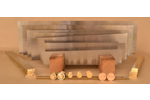- Rebate Saw-Plane Parts -





While the most recent reincarnation of this hybrid saw-plane has been branded a "kerfing plane" by Tom Fidgen, this form has been around for centuries.
Although early versions (including the stair saw and the joinery saw described by Roubo in 1769) had a saw blade mounted in a plane body, they lacked the fence that make this saw-plane so useful for certain ripping operations.
In 1866, a patent was granted to Daniel Whitker for his "saw-rabbet plane", the earliest documentation I have found of a fence being added to this form. In his patent application, he described the plane as a "...new and useful tool or instrument for rabbeting and plowing or grooving lumber...". These functions are just as useful as kerfing a board for resawing.
Rebate saw-plane blade specifications and features:
- 10" long x 1 5/8" wide.
- Made from 1095 spring steel, Rc 48-51.
- 0.028", 0.032", or 0.042" thick (to match frame saw blades).
- 4 1/2 ppi teeth cut aggressively, yet leave a smooth surface.
- Modified gullets increase the sawdust clearing capability.
- Blade is deblued, but not sanded or polished. Can be used as-is, or the small scratches and scuffing can be sanded out.
The blade can be purchased sharpened and set (ready to install out of the box) or unsharpened. The unsharpened blade comes with the triangular portion of the teeth punched; you will need to sharpen and set the teeth, then file in the rounded gullet bottom. Sharpening requires an 8" Regular taper saw file (available below or here) and a 5/32" chainsaw file (available at any good hardware store).
Fence hardware specifications and features:
- Arms are approximately 5 1/4" long.
- Precise design ensures that the fence remains parallel to the blade over its entire range of travel.
- Locking mechanism is very secure, yet easy to engage.
- Hardware kit includes arms/fence rods (steel), bearing cups (steel), fence sleeves (bronze), arm bolts (brass or bronze), wing bolts (steel), bearing washers (steel), and arm locks (brass).
- Wood is NOT included.
While the hardware installation is straightforward, it does require some precision to ensure proper function. You will need a drill press, good 3/16" and 7/16" brad point bits, and 9/16" and 3/4" piloted counterbores (with a 3/16" pilot) or Forstner bits (the counterbores are easier to use, but more expensive).
Plans for making your own rebate saw-plane are available as a pdf at the link in the upper right corner of this page. The plans include sources and part numbers for the needed tooling.
Use the rebate saw-plane for:
- Cutting a kerf around a board for resawing.
- Plowing narrow grooves.
- Cutting rabbets - this saw-plane does quick work, particularly in softer woods.
Made in the USA.
 |
| Rebate saw-plane |
Related resources:
- Mike Siemsen's Roubo frame saw build: Mike chronicled his saw build on his
School of Woodworking blog.
- Roubo frame saw build lesson: Shannon Rogers of The Hand
Tool School offers a Roubo frame saw build lesson as part of
his curriculum.
Many thanks to Shannon Rogers of The Hand
Tool School for this video of his Roubo frame saw in action.







